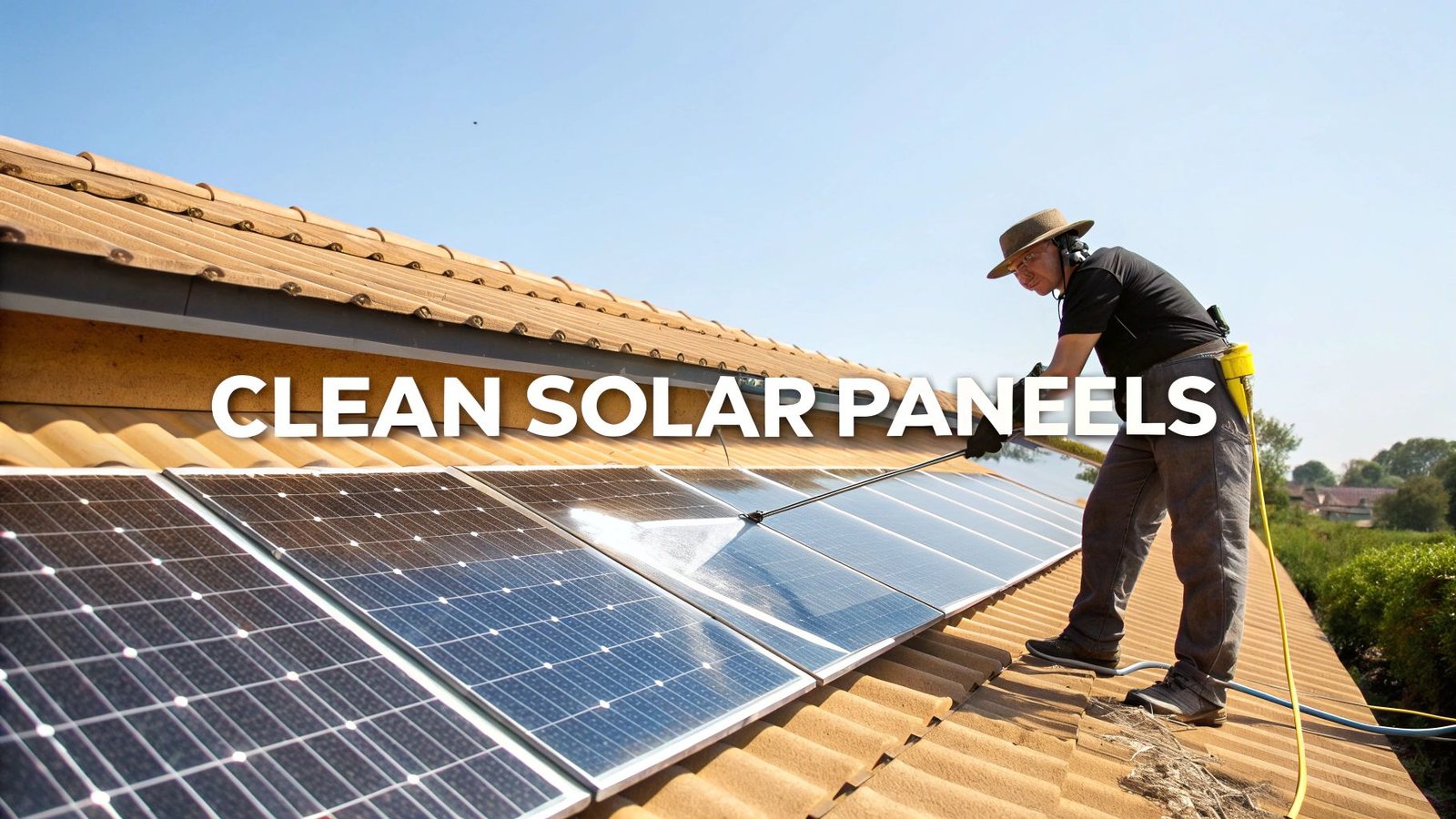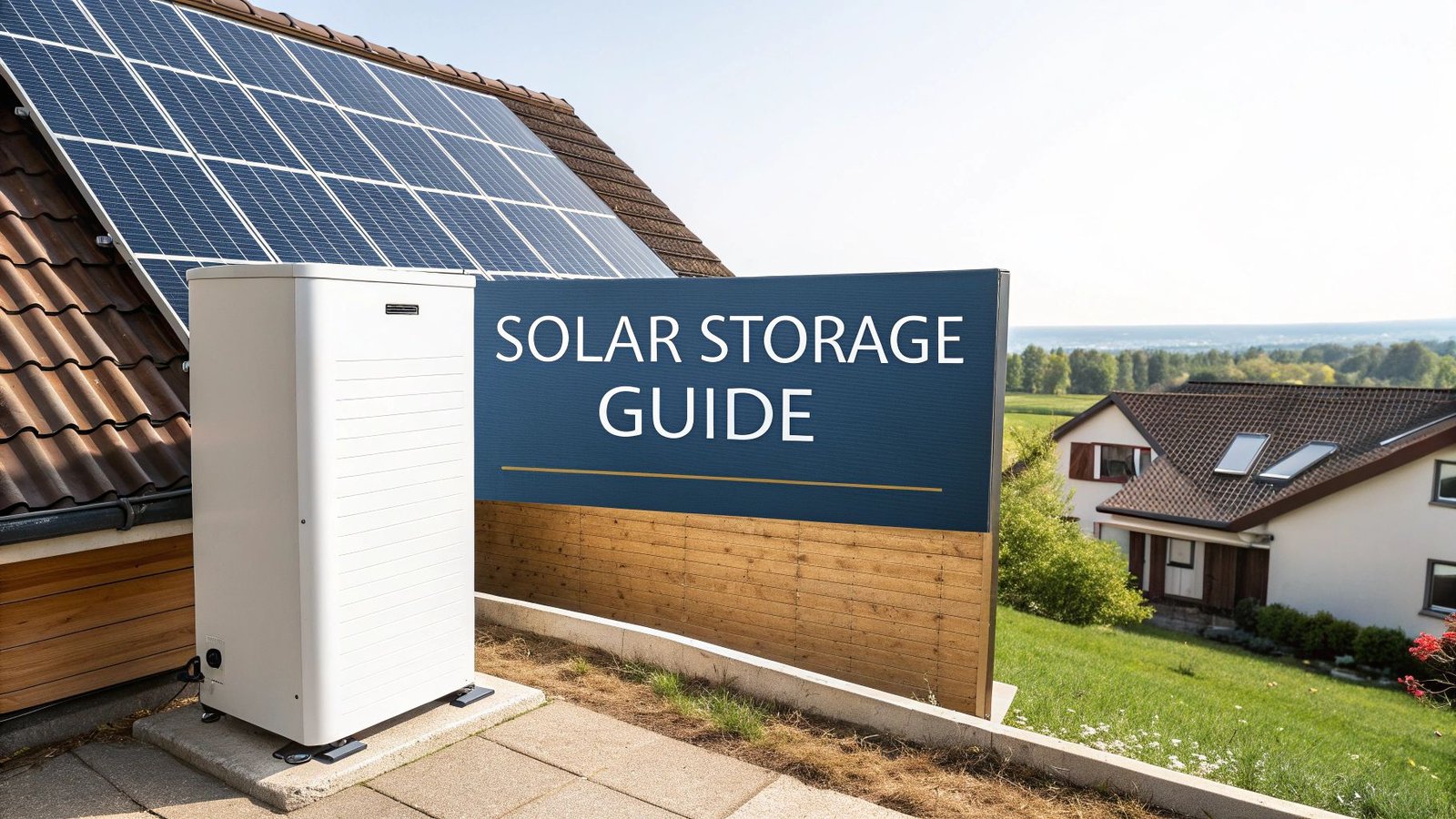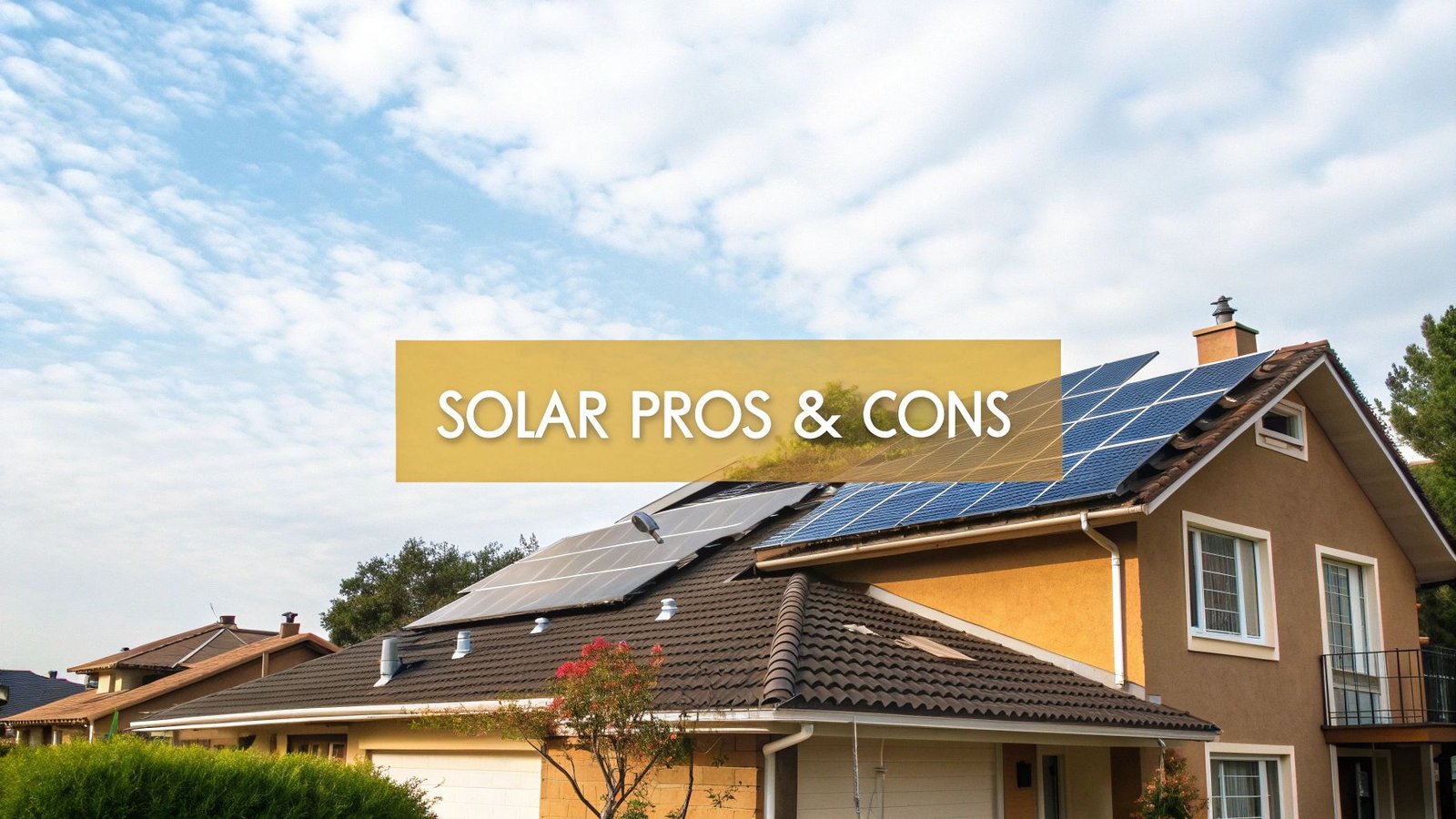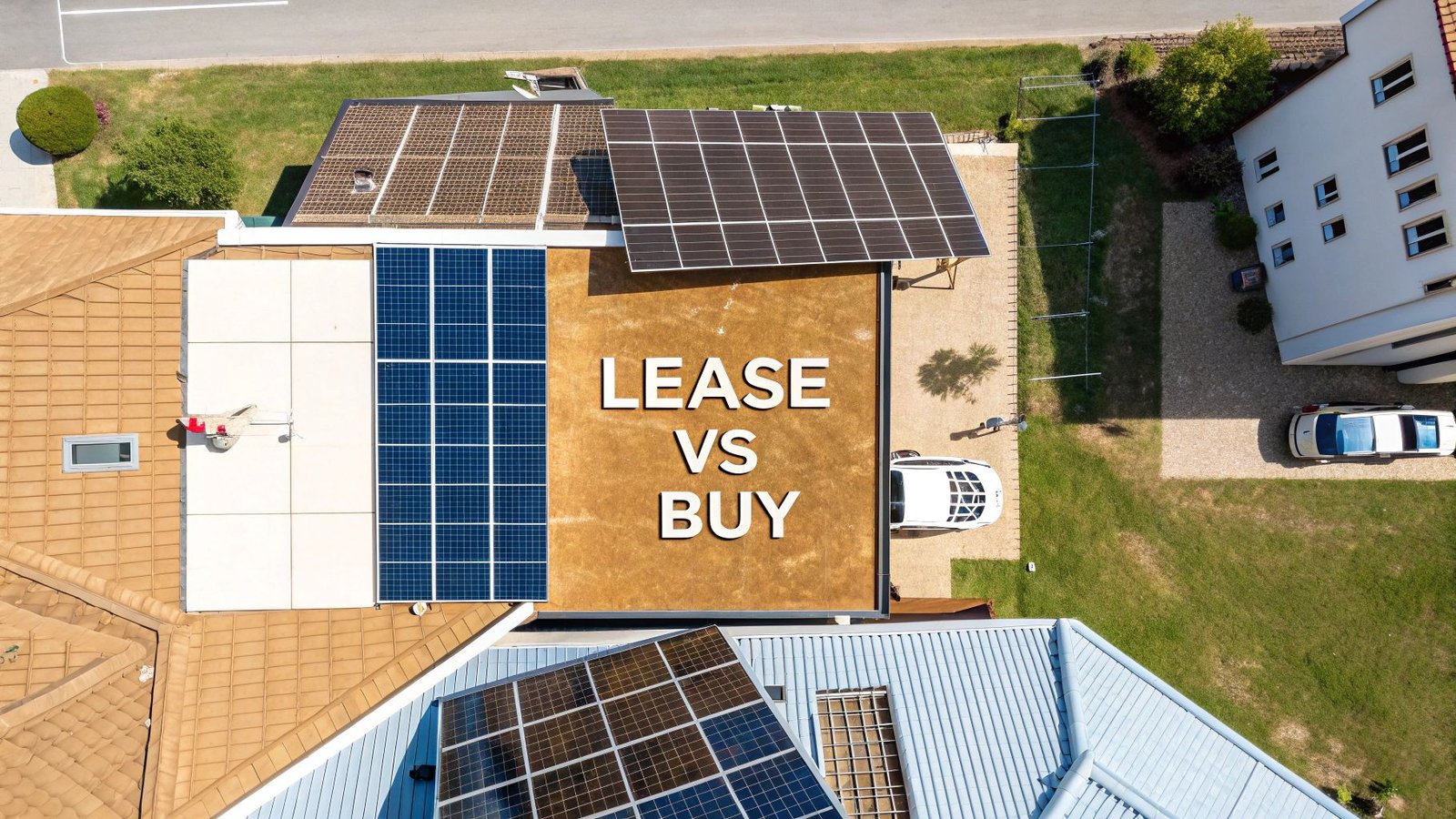That thin layer of dust and grime on your solar panels? It might seem harmless, but it's quietly chipping away at your system's energy production and costing you money. Think of it this way: keeping your panels clean is one of the easiest and most direct ways to maximize your return on investment and protect your solar setup for the long haul.
Why Cleaning Your Solar Panels Is a Bright Idea

A dirty solar panel is a lot like a dusty window—it just can't let as much light through. The same concept applies to your solar array. Everyday buildup from pollen, city pollution, and the occasional bird dropping creates a film that blocks sunlight from reaching the photovoltaic cells.
Just how much of a difference does it make? Research has shown that heavy soiling can slash your solar panel's energy output by as much as 30%. Suddenly, that little bit of dust doesn't seem so trivial.
graph TD
A[Clean Solar Panel<br>100% Efficiency] --> B(Sunlight);
B --> C{Photovoltaic Cells};
C --> D[Maximum Energy Production];
subgraph "Impact of Dirt and Debris"
E[Dirty Solar Panel] --> F(Blocked Sunlight);
F --> G{Reduced Light Absorption};
G --> H[Energy Loss up to 30%];
end
style A fill:#9f9,stroke:#333,stroke-width:2px
style D fill:#9f9,stroke:#333,stroke-width:2px
style E fill:#f99,stroke:#333,stroke-width:2px
style H fill:#f99,stroke:#333,stroke-width:2px
How Common Debris Impacts Solar Panel Output
Not all grime is created equal. A quick look at how different types of buildup can affect your panel's efficiency really highlights the value of keeping them clean.
bar-chart
title "Potential Efficiency Loss by Debris Type"
"Dust and Pollen" : 10
"Bird Droppings" : 15
"Pollution/Soot" : 25
"Heavy Soiling" : 30
| Type of Debris | Potential Efficiency Loss | Frecuencia de limpieza recomendada |
|---|---|---|
| Dust and Pollen | 5-10% | Annually or Bi-annually |
| Excrementos de aves | 10-15% | As needed |
| Pollution/Soot | 15-25% | Quarterly in urban areas |
| Heavy Soiling | Up to 30% | Based on monitoring |
As you can see, even a seemingly small amount of dust can have a noticeable effect, while more stubborn grime can seriously hinder performance.
Capturing maximum energy isn't just about cleaning; the technology itself plays a huge role. For instance, exploring the los mejores paneles solares marinos shows how some units are specifically designed to withstand and perform in tough, often dirty, environments.
At the end of the day, this is about more than just appearances. A clean system works better, generates more electricity, and keeps more money in your pocket. If you're looking for more ways to get the most out of your setup, we have plenty of other resources on https://radiantenergysolar.com/tag/solar-panel-optimization/ that can help.
Your Pre-Cleaning Safety Checklist

Before you even grab a hose, let's talk about safety. I can't stress this enough: working on a roof near a live electrical system is serious business. A little prep work goes a long way in protecting you and your solar investment.
Your very first move is always to shut down the entire system. This means turning off both the DC disconnect and the AC breaker. Every system is a bit different, so pull out your manufacturer's manual and follow their specific shutdown procedure to the letter. Don't guess.
Assess Your Environment
Timing is everything. The best time to clean your panels is on a cool, overcast day or very early in the morning. Hot, direct sunlight will make your cleaning solution evaporate in a flash, leaving behind a streaky residue. Plus, the panels themselves can get surprisingly hot—hot enough to burn you.
Before you set up, do a quick inspection of the area, both on the ground and on the roof.
- Ladder Check: Make sure your ladder is planted on solid, level ground. It needs to extend at least three feet above the edge of the roof for safe access.
- Roof Condition: Look for loose shingles, wet patches, or any debris that could cause you to lose your footing.
- Wiring Awareness: Know where all the power lines are and keep your equipment far away from them. If you spot any frayed or damaged wires on the panels themselves, stop immediately. Our guide on repairing solar panels can help you identify these hazards.
Remember, even when "off," some components in a solar system can still hold a charge. If you’re at all unsure about the shutdown process, or if the height and pitch of your roof make you nervous, calling a professional is the smartest move you can make.
The solar cleaning industry is always evolving, with new tools and techniques emerging for both wet and dry cleaning. The wet cleaning method—which is what you'll be doing—is the most common, but water-saving dry methods are gaining ground. A professional will have the right gear and safety knowledge for any situation.
Getting the Right Tools for the Job
Before you even think about climbing a ladder, let's talk about tools. Grabbing the wrong equipment is the fastest way to turn a simple cleaning task into a costly mistake. I’ve seen it happen—homeowners reach for a pressure washer or a stiff-bristled brush and end up with permanently damaged panels.
These common household tools can easily strip away the delicate anti-reflective coating on the glass, which is essential for maximizing energy absorption. Once that coating is gone, so is some of your system's efficiency. The key is to be gentle.
Your Solar Panel Cleaning Toolkit
Think of this like washing a brand-new car. You wouldn't take steel wool to the paint job, right? The same principle applies here. Your goal is to lift away dirt, dust, and grime without leaving a single scratch behind.
Here’s a look at the right tools for the job versus the common items that can cause more harm than good.
| Recommended Tool | Why It Works | What to Avoid | Reason to Avoid |
|---|---|---|---|
| Soft-Bristle Brush | Gently lifts dirt without scratching the panel's anti-reflective coating. | Coarse brushes or abrasive pads | Creates micro-scratches that scatter sunlight and reduce power output over time. |
| High-Quality Squeegee | Removes water cleanly, preventing mineral spots that act like tiny shades blocking sunlight. | Letting panels air-dry | Hard water minerals get left behind as residue, which significantly hurts efficiency. |
| Garden Hose (low pressure) | Provides a gentle rinse to wash away loosened debris and soap without damaging seals. | High-pressure washer | Can force water past the panel seals, cause micro-cracks in the cells, and strip coatings. |
| Non-abrasive Soap | A simple mix of water and a small amount of mild, biodegradable dish soap is all you need. | Harsh detergents or chemicals | Can corrode the aluminum frame, degrade the seals, and damage the surface coating. |
A good rule of thumb: If you wouldn't use it on your car's paint, don't use it on your solar panels. It’s that simple.
Getting the tools right is a huge part of proper solar care. For a deeper dive into maintaining your whole system, our solar panel maintenance checklist offers a ton of professional tips.
With this kit in hand, you're ready to clean your panels like a pro, ensuring they perform at their best for years to come.
A Practical Method for Spotless Solar Panels
Alright, you've got your gear and you’ve run through the safety checks. Now for the actual cleaning. This is the method I’ve used time and time again to get panels gleaming without causing any damage. Forget what you've read on random forums; this is a straightforward workflow for a streak-free finish that will have your system running at peak performance.
The whole process really just comes down to a simple rinse, wash, and dry cycle.
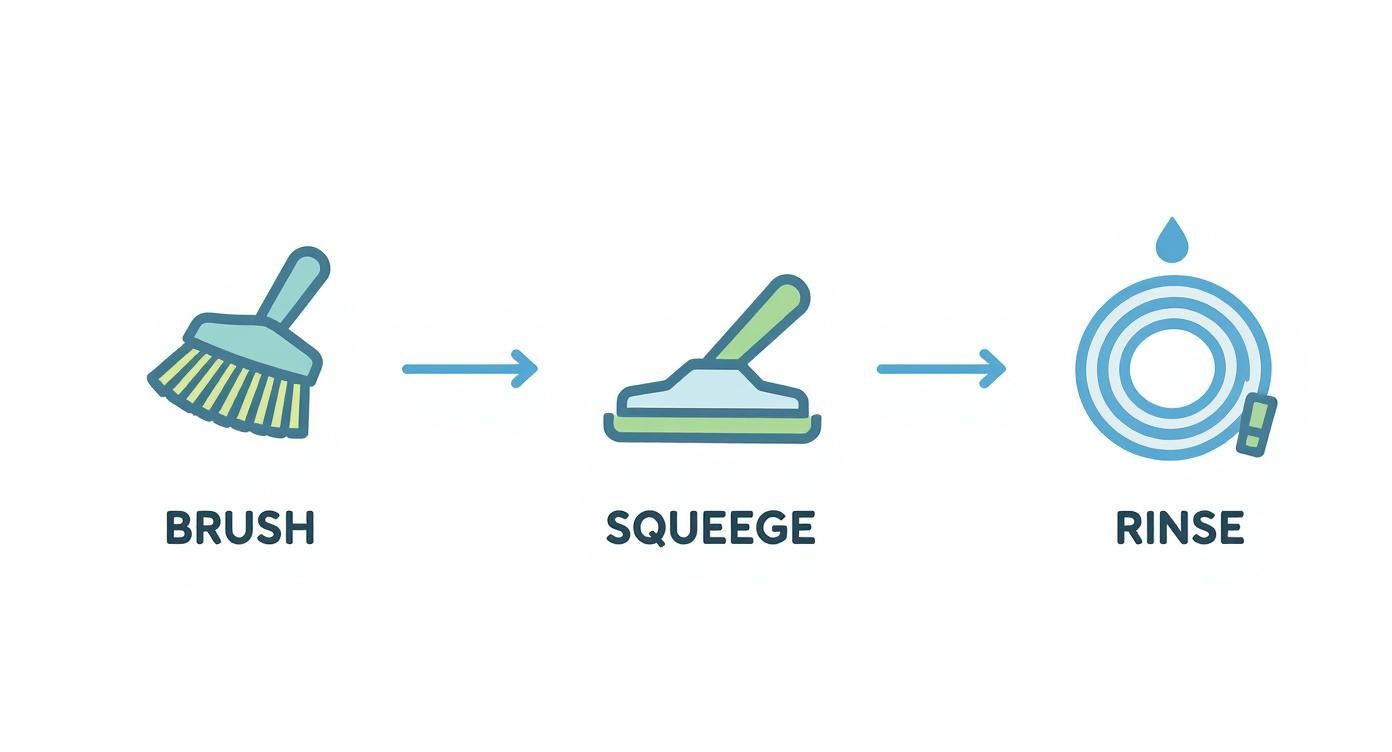
As you can see, there's a logical flow here. You start with the soft brush, then rinse, and finish with the squeegee. Following this order is the secret to preventing the two biggest enemies of panel efficiency: scratches and residue.
The Initial Rinse and Gentle Wash
First things first, give the panels a light rinse with a regular garden hose. Whatever you do, never use a pressure washer. The goal here is just to knock off the loose dust and dirt sitting on the surface. Getting this stuff out of the way first means you won't be grinding grit into the glass during the next step.
With the initial rinse done, it's time to wash. Dip your soft-bristle brush into a bucket filled with clean water and a small amount of a panel-safe, biodegradable soap. Start at the top of a panel and work your way down, gently scrubbing the entire surface with smooth, overlapping strokes. Always work from top to bottom—it’s just common sense. This keeps dirty water from trickling down over the areas you’ve just cleaned.
Consejo profesional: Got some stubborn bird droppings? Don't just scrub harder. Let the soapy water soak on the spot for a few minutes to soften it up. Resist the urge to apply a ton of pressure; that’s how you get micro-scratches.
Achieving a Spotless Finish
The final rinse is just as critical as the wash itself. You have to get every bit of soap off the glass. Any film left behind is a magnet for new dust and can create a haze that blocks precious sunlight. Rinse each panel thoroughly, again moving from top to bottom, until you see the water running completely clear.
Don't wait around—grab your squeegee and start drying immediately after you finish rinsing. Begin at the top edge and pull the squeegee straight down in one smooth motion. Overlap each pass slightly and, this is key, wipe the blade with a clean microfiber cloth after every single stroke. This prevents you from dragging grime back across the clean panel. Skipping this step is a recipe for mineral spots from hard water, which can be just as bad as a layer of dust.
While this hands-on method works great for most homeowners, it’s worth noting that the industry is also embracing other techniques. Semi-automated cleaning systems are becoming more common for both homes and businesses because they're getting more affordable and easier to use. These can range from advanced manual tools to full-on robotic cleaners. You can discover more insights about these cleaning market trends here.
How Often Should You Really Clean Solar Panels?
When it comes to cleaning solar panels, there’s no magic number. The right schedule isn't about a generic calendar reminder; it's about what’s happening in your specific environment.
Think about it this way: a solar array on a suburban home where it rains frequently might only need a good cleaning once a year. The rain does a decent job of rinsing away the light layers of dust and pollen. But if your panels are out in a dry, dusty field or right next to a busy highway, you might need to clean them every three to six months to keep them running at their best.
Letting Your Panels Tell You When They're Dirty
Instead of just guessing, it's better to learn how to read the signs. Your system will give you clear clues when it's time for a wash. The two best ways to know are by looking at them and checking their performance data.
- The Eyeball Test: This is the simplest method. Can you see a visible film of grime, dust, or bird droppings from the ground? If the answer is yes, that gunk is definitely hurting your energy production.
- Control del rendimiento: For a more precise answer, dive into your system's energy output data. If you see a noticeable dip in production that isn't just because of a few cloudy days, that's a huge red flag that dirty panels are the problem.
A sudden, unexplained drop in your system's energy output is the clearest signal you can get. When you see that trend, don't wait for your next scheduled cleaning—it's time to act.
Different locations come with different challenges. The table below gives you a solid starting point for figuring out your own cleaning schedule.
Recommended Cleaning Frequency Based on Environment
| Environmental Factor | Suggested Cleaning Schedule |
|---|---|
| High Pollen/Agriculture | Every 3-6 months |
| Urban Pollution/Soot | Every 6 months |
| Coastal Salt Spray | Every 6-12 months |
| Low-Dust Suburban | Annually |
Ultimately, building a custom schedule based on what you see and the data you collect is far better than sticking to a rigid timeline. For more context on maintaining outdoor surfaces, understanding optimal cleaning frequency for outdoor installations can offer some helpful parallels. This proactive approach ensures you clean your panels only when they truly need it, saving you time and maximizing your system's efficiency.
Have a Few More Questions About Cleaning Your Solar Panels?
It's natural to have a few lingering questions before you get started. Let's walk through some of the most common things people ask so you can feel completely ready to tackle the job.
Can I Just Use Water From My Garden Hose?
You can, but it’s not always the best idea, especially if you live in an area with hard water. That regular tap water is full of minerals like calcium and magnesium, and when it evaporates, it can leave behind a chalky, spotty residue. Think of these spots as tiny shadows blocking the sun.
For a truly spotless finish, rinsing with deionized or distilled water is the way to go. If you don't have that handy, the next best thing is to squeegee the glass completely dry right after you rinse with tap water. This one extra step is your best defense against mineral buildup and helps keep your panels working efficiently.
Should I Just Hire a Professional Cleaner?
Honestly, it depends. If your panels are on a steep, multi-story roof or you're just not a fan of heights, calling in a pro is absolutely the right call. They have the proper safety equipment, specialized tools (like water-fed poles), and most importantly, liability insurance. They’ll get it done safely and quickly.
On the other hand, if your panels are easy to get to—say, on a ground-mounted system or a low-slope, single-story roof—cleaning them yourself is a perfectly reasonable and budget-friendly project. It really boils down to how accessible your system is and what you're comfortable with.
pie
title "When to DIY vs. Hire a Pro"
"DIY Cleaning (Accessible & Safe)" : 40
"Professional Cleaning (Steep/High Roof)" : 60
Consejo profesional: The best time to wash your panels is early in the morning, later in the evening, or on a cool, overcast day. If you try to clean them in the blazing midday sun, the water will evaporate almost instantly, leaving behind streaks and mineral spots—exactly what you're trying to get rid of.
Getting the timing and the technique right is what makes all the difference in boosting your energy output.
If you'd rather leave it to the experts for a guaranteed safe, streak-free clean, the team at Energía radiante is here to help. Contact us today for a free consultation and ensure your solar investment is performing at its best.

